Thursday 3 November 2016
White: K. Nevols (134) - Black: I. Lappin (125)
My opponent was someone you could not prepare for - he has a wide range of opening set-ups and tactics. I had a very difficult game last year and prepared myself for another tough battle.
1. e4 d5
Now here's a funny thing. I face the opening I have made into my own defence!
2. exd5 Qxd5
3. Nc3 Qe6+
Unusual. I play Qa5, while Qd6, Qe5+ and Qd8 are all sometimes seen. Now 4. Be2 could be met by the annoying 4. .. Qg6. Perhaps 4. Nge2 is best. All the same, I decide to let the queens go early.
4. Qe2 Qxe2+
5. Bxe2 Bf5
Already time for the thinking cap. White should now play 6. Nd5 and after 6. .. Kd8 7. Ne3 Bg6 8. Nf3 is developing nicely.
6. d3
But this is not so good for the simple reason that it holds up the kingside development.
6. ... c6
7. Nf3 h6
8. Nd4 Bh7
Now I have in mind whether I can play any tactics on the queenside with moves around Bf3 and Nb5.
9. Bf3 Nd7
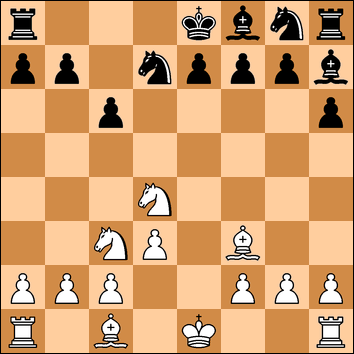
White should now either castle or play Be3 keeping an edge. Instead here comes the first blunder of the game. I still had in mind plans around Nb5 and decided to develop my bishop towards the c7 square - and completely overlooking a fork.
10. Bf4?? e5
Simple when you see it - highly annoying when you don't. Grumbling silently, I tried to see how I could get something for the piece. I considered 11. Ncb5? cxb5 12. Nxb5 but 12. .. Kd8 or better 12. .. Rc8 keeps Black well ahead.
I looked at castling and, after pawn takes something, then Re1+ but there's nothing there - simply Be7.
Finally I thought I might tempt him into a mistake and get two pawns for the piece.
11. Nxc6
If now 11. .. bxc6 12. bxc6 Rc8 13. Bxd7+ Kxd7 14. Be3 (14. Bxe5?? Re8 with f6 to follow) and I would have two pawns for the piece with a beady eye on the a7 pawn and a Black king in the centre with an undeveloped kingside. I would have to throw the kitchen sink to get a swindle out of that.
Black chooses the other capture.
11. ... exf4
12. Na5
My original plan was 12. .. Rb8 and something takes on b7. However if 13. Nxb7 then 13. .. Ne5 is good (14. Bd5 Nf6) and if 13. Bxb7 then 13. .. Bb4! So after 12. .. Rb8 White has to castle queenside and Black can then continue developing with 13. .. Be7 and Ngf6 - the pawn on b7 is still poisonous.
12. ... Bb4
My first piece of luck - he does not find 12. .. Rb8 and the second pawn goes.
13. Nxb7 Rb8
14. O-O-O
OK, now the b2 point is defended and I can get a rook onto the e-file.
14. ... g5!?
I did not expect this. The point is to threaten 15. .. g4 and remove a square from the bishop - but I think 14. .. Ngf6 is better.
15. Nb5
I have my eye on the c7 square for a check and also thinking of c3 and Re1 check.
15. ... Ngf6
Black shows no fear!! But I win the exchange.
16. Nc7+ Kf8
17. Na6 Rxb7
18. Bxb7 Bd6
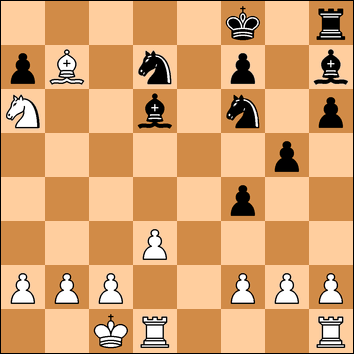
OK, I say to myself, I am back in the game. I have a rook and two pawns versus a knight and bishop. But his pieces are very active and he can bring the rook into the game with Kg7. My first task must be to get those pieces stuck on the left hand side back into the centre - starting with the knight which is dominated by the bishop.
19. a3 Bf5
20. Nb4 Nc5
21. Bc6 Be6
22. Bb5 Kg7
23. Bc4 Ng4
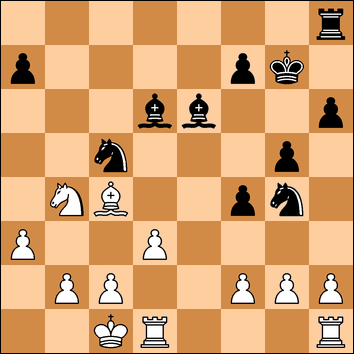
Black has played the last few moves very well - his four minor pieces are becoming very active while I am keen to ease the pressure by swapping off a bishop.
Now I gave some thought to 24. Bxe6 Nxf2 25. Bc4 Nxh1 26. Rxh1 which results in an ending in which I am a pawn up. But better for Black would be the simple 24. ... Nxe6.
I also considered 24. f3? Nf2 25. Bxe6 but then again simply 25. .. Nxe6 and my rooks remain forked.
I instead decided I had to grovel and defend the f-pawn. However 24. Bxe6 is a better move.
24. Rdf1 Rc8
A good square for the rook but allowing me to exchange a bishop. The computer likes 24. .. f3 forcing 25. g3.
25. Bxe6 fxe6
26. h3
Another sigh of relief at being able to get the knight away. I now expected 26. .. Ne5 (which threatens Bxb4 and Nxd3) after which I would play 27. Kd2.
An interesting move for Black would be 26. .. f3!? with 27. gxf3 Ne5 which gives a wonderful square on f4 for a Black knight or bishop.
26. ... a5
But this keeps up the pressure. Moving the knight allows Nxd3 (or even Nxf2 and then Nd3) whereas 27. hxg4 axb4 28. axb4 Nd3+ 29. Kd2 Nxb4 and Black has won a pawn.
27. Kd2 Na4?
At last Black makes a mistake. 27. .. Nxf2 28. Rxf2 axb4 29. axb4 Na4 keeps Black's advantage and ties White down to a difficult defence. But now I could see a way I might get put a defence together.
28. hxg4 axb4
29. b3 Nc3
30. a4
Now I must remember the possibility of running with that a-pawn.
30. .... Bc5
Tying down the rook on f1. So I have a big think and cobble together some kind of counterplay. I need to release the rooks and decide the f2 pawn is better defended from f3 so I could think about a plan involving g3 - but self-trapping the rook on f3 is quite brave.
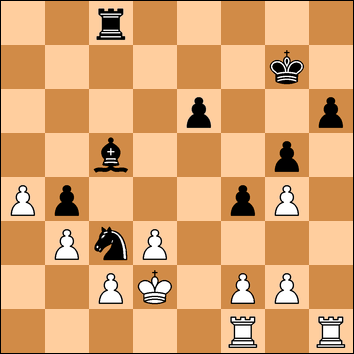
31. Rh3 Bb6
32. Rf3 e5
33. Re1
However, now 33. ... h5! rolls up the kingside. The forced line goes 34. Rxe5 Kf6 35. Rf5+ Kg6 36. Re5 hxg4 37. Re6+ Kf7 38. Rxb6 and then Black might spot 38. ... Nc1+!! 39. Kc1 Na3 40. c4 bxc3 41. Rxf4+ gxf4. Still, a tough one to play.
33. ..... Kf6
But nothing wrong with playing simple defence.
34. g3 h5
Playing 34. ... Bd4 is also simple and strong.
Throughout these moves I had to keep my rook on the back rank as I was concerned about the manoeuvre Nb1+ and Nc3.
35. gxf4
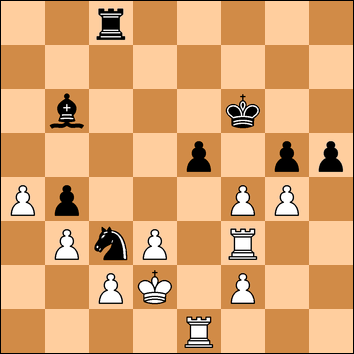
Now Black should play 35. .. exf4 and then 36. gxh5 Kf5! with the threat of g4, forcing 37. Rh3 Bxf2. With the two passed pawns and the bishop coming to e3, White could consider resigning.
35. .... hxg4?
Glory be!! A mistake.
36. fxe5+
Black had overlooked that this was double check - and that he would have no time to take the rook.
36. .... Kg7
37. Rf5 Bd8
Now 38. Rg1 is best to pick up the pawns but I was still worried about the knight so instead I thought I get play by advancing the pawn.
38. e6 Bf6
Now Black threatens Nxa4 and Bc3+.
39. Ra5
With the idea of defending against this threat and infiltrating to the seventh rank.
39. ... Rd8
40. Ra7+ Kg6
41. Rd7 Re8
42. d4
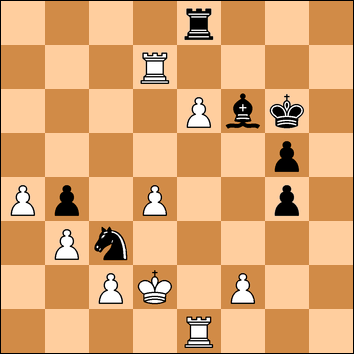
I was full of confidence now and thought if I could get a pawn to d5 then the win is there. But Black could now play 42. ... Kf5! 43. d5 Ne4+ and suddenly it is still in balance. 42. a5 might have been better.
42. .... Bg7
43. Kd3
Another reason why I wanted to play d4 was to get some room for the King. Black should now return the bishop to f6 - 43. .. Bf6 - to cover the e7 square. Then he could consider playing Kf5. After 43. .. Bf6 44. d5 Kf5 White has a choice of 45. a5 or 45. e7 - I would probably have preferred the former.
Fortunately (for me) Black makes the last mistake - and forgot he had moved the bishop.
43. .... Kf5??
44. Rxg7
Black now resigned.
A dramatic and exhausting game where I was forever just trying to survive after my blunder on move 10. Until Black's 35th move, I was behind and even then nothing was clear. Yet again a game I probably did not deserve to win - but then I would argue that, with the fight I put up, I perhaps did not deserve to lose either.
No comments:
Post a Comment